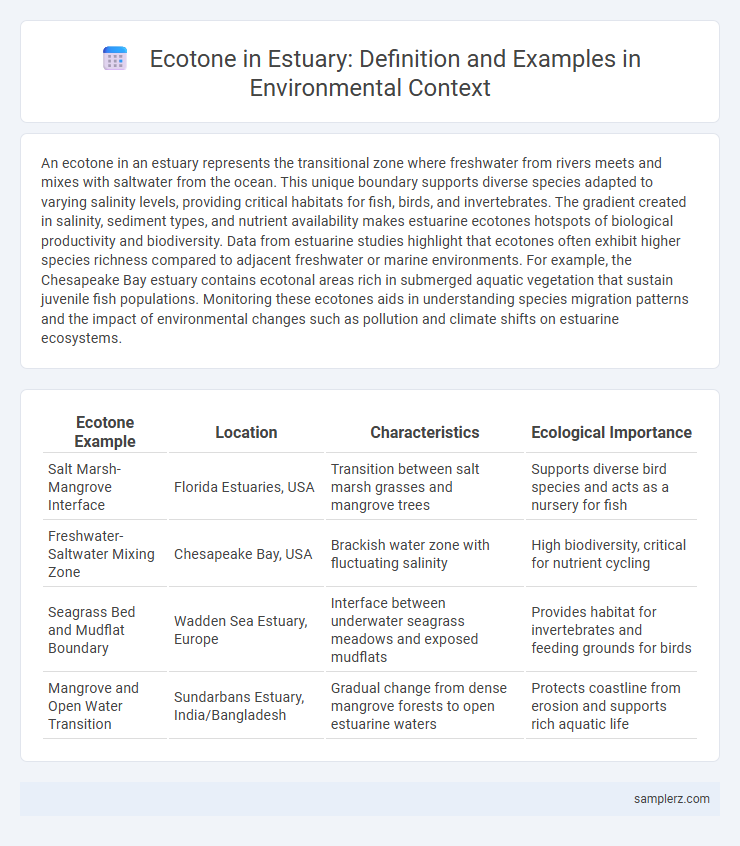An ecotone in an estuary represents the transitional zone where freshwater from rivers meets and mixes with saltwater from the ocean. This unique boundary supports diverse species adapted to varying salinity levels, providing critical habitats for fish, birds, and invertebrates. The gradient created in salinity, sediment types, and nutrient availability makes estuarine ecotones hotspots of biological productivity and biodiversity. Data from estuarine studies highlight that ecotones often exhibit higher species richness compared to adjacent freshwater or marine environments. For example, the Chesapeake Bay estuary contains ecotonal areas rich in submerged aquatic vegetation that sustain juvenile fish populations. Monitoring these ecotones aids in understanding species migration patterns and the impact of environmental changes such as pollution and climate shifts on estuarine ecosystems.
Table of Comparison
| Ecotone Example | Location | Characteristics | Ecological Importance |
|---|---|---|---|
| Salt Marsh-Mangrove Interface | Florida Estuaries, USA | Transition between salt marsh grasses and mangrove trees | Supports diverse bird species and acts as a nursery for fish |
| Freshwater-Saltwater Mixing Zone | Chesapeake Bay, USA | Brackish water zone with fluctuating salinity | High biodiversity, critical for nutrient cycling |
| Seagrass Bed and Mudflat Boundary | Wadden Sea Estuary, Europe | Interface between underwater seagrass meadows and exposed mudflats | Provides habitat for invertebrates and feeding grounds for birds |
| Mangrove and Open Water Transition | Sundarbans Estuary, India/Bangladesh | Gradual change from dense mangrove forests to open estuarine waters | Protects coastline from erosion and supports rich aquatic life |
Defining Ecotones in Estuarine Environments
Ecotones in estuarine environments represent transitional zones where freshwater from rivers meets and mixes with saltwater from the ocean, creating unique gradients of salinity and biodiversity. These areas support diverse plant and animal species adapted to fluctuating salinity levels, such as salt marsh grasses and estuarine fish species. The dynamic interplay of physical and chemical factors in estuarine ecotones enhances nutrient cycling and productivity, making them critical habitats for ecological resilience and fisheries.
Key Ecotone Characteristics in Estuaries
Estuarine ecotones exhibit dynamic gradients where freshwater from rivers meets saline ocean water, creating a unique brackish environment that supports diverse biological communities. These transitional zones feature fluctuating salinity, nutrient-rich sediments, and variable hydrodynamic conditions essential for key species like mangroves, salt marsh plants, and various fish nurseries. The combination of mixing waters and sediment deposition fosters high productivity and biodiversity, making estuary ecotones critical for ecological resilience and habitat complexity.
Mangrove-Saltmarsh Transitions: A Prominent Estuarine Ecotone
Mangrove-saltmarsh transitions represent a prominent estuarine ecotone characterized by the dynamic interface between salt-tolerant mangrove forests and herbaceous saltmarsh plants. This ecotone plays a critical role in nutrient cycling, sediment stabilization, and providing habitat for diverse estuarine fauna such as fish and crustaceans. The spatial distribution and composition of these transitional zones are influenced by tidal gradients, salinity fluctuations, and climate factors, making them essential for maintaining estuarine ecosystem resilience.
Tidal Mudflat and Saltmarsh Interface
The tidal mudflat and saltmarsh interface in estuarine ecotones hosts a rich biodiversity due to the dynamic exchange of nutrients and sediment. This transitional zone supports key species like cordgrass and benthic invertebrates, which contribute to coastal protection and carbon sequestration. High tidal fluxes create unique habitats that sustain nesting birds and juvenile fish, enhancing ecosystem productivity.
Brackish Water Zones as Ecotones
Brackish water zones in estuaries exemplify ecotones, where freshwater from rivers meets and mixes with saline ocean water, creating unique habitats with fluctuating salinity levels. These transitional zones support diverse species adapted to varying salinity, such as mangroves, oysters, and various fish species, making them biodiversity hotspots. The dynamic environmental gradients in estuarine ecotones play a crucial role in nutrient cycling and serve as nurseries for many marine organisms.
Freshwater and Seawater Mixing Zones in Estuaries
Ecotones in estuaries represent dynamic zones where freshwater from rivers meets and mixes with seawater from the ocean, creating unique brackish water habitats. This mixing zone supports diverse biological communities adapted to varying salinity levels, including specialized fish, invertebrates, and plant species like salt marsh grasses and mangroves. These transitional environments are crucial for nutrient cycling, serve as nurseries for many marine species, and act as natural buffers protecting inland areas from storm surges.
Vegetation Shifts Along Estuarine Ecotones
Vegetation shifts along estuarine ecotones demonstrate the dynamic interplay between freshwater and saltwater environments, where salt-tolerant mangroves gradually replace freshwater marsh plants moving seaward. These transitional zones feature diverse plant communities such as Spartina alterniflora dominating lower salt marshes and Phragmites australis flourishing in upper freshwater-influenced areas. The spatial variation in salinity and tidal influence drives these vegetation patterns, critical for maintaining estuarine ecosystem health and biodiversity.
Wildlife Biodiversity at Estuarine Ecotones
Estuarine ecotones, where freshwater meets marine environments, support high wildlife biodiversity due to the mixing of nutrients and habitats. Species such as migratory birds, fish, and shellfish thrive in these transitional zones, benefiting from abundant food resources and diverse shelter options. The dynamic interplay of salinity gradients and tidal influences creates unique ecological niches essential for sustaining various aquatic and terrestrial organisms.
Ecological Importance of Estuarine Ecotones
Estuarine ecotones, where freshwater from rivers meets saline ocean water, create highly productive environments rich in biodiversity and nutrient cycling. These transitional zones support critical habitats for spawning fish, migratory birds, and diverse invertebrates by offering shelter and abundant food resources. The dynamic nutrient exchange and varied salinity gradients in estuarine ecotones enhance ecosystem resilience and promote water quality improvement through natural filtration processes.
Human Impact on Estuary Ecotones
Estuary ecotones, where freshwater meets saltwater, are highly sensitive to human activities such as urban development, industrial pollution, and land reclamation. These impacts disrupt the delicate salinity gradients and sediment deposition patterns, leading to habitat degradation and loss of biodiversity in species like migratory fish and shorebirds. Preservation efforts must prioritize reducing nutrient runoff and controlling coastal construction to maintain the ecological integrity of estuarine ecotones.

example of ecotone in estuary Infographic
 samplerz.com
samplerz.com